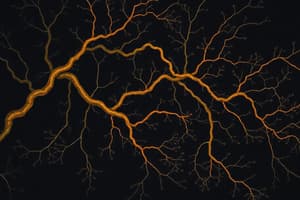Podcast
Questions and Answers
What is the main function of amacrine cells in the retina?
What is the main function of amacrine cells in the retina?
- Transmitting visual signals to the brain
- Regulating color and luminosity under changing light (correct)
- Sensing touch and pressure
- Detecting rapid vibrations
Which pathway is primarily responsible for processing color contrast in vision?
Which pathway is primarily responsible for processing color contrast in vision?
- Parvocellular pathway (correct)
- Optic nerve pathway
- Magnocellular pathway
- Retinal pathway
Which nucleus of the hypothalamus is responsible for regulating thirst and water balance?
Which nucleus of the hypothalamus is responsible for regulating thirst and water balance?
- Supraoptic nucleus (correct)
- Lateral hypothalamus
- Suprachiasmatic nucleus
- Posterolateral hypothalamus
What is the primary function of the cerebellum?
What is the primary function of the cerebellum?
Which type of aphasia is characterized by impaired comprehension of spoken and written language?
Which type of aphasia is characterized by impaired comprehension of spoken and written language?
Flashcards are hidden until you start studying
Study Notes
Visual System
- Human eye's visible light range: 370-740 nm
- Amacrine cells regulate color and luminosity in changing light.
- Parvocellular pathway (lateral geniculate body to visual cortex) is most sensitive to color contrast.
- Visual cortex blobs process color.
Somatosensory System
- Pacinian corpuscles detect rapid touch, pressure, and vibration.
Nervous System: Huntington's Disease & Limbic System
- Huntington's disease degenerates GABAergic neurons in the caudate nucleus.
- Cingulate gyri, amygdala, and other structures comprise the limbic system.
Language & Speech
- Wernicke's aphasia impairs understanding spoken and written language.
- Broca's aphasia affects word formation.
- Broca's area is located in the inferior frontal gyrus.
Hypothalamus
- Supraoptic nucleus controls thirst and water balance.
- Suprachiasmatic nucleus regulates circadian rhythm.
- Posterolateral hypothalamus controls shivering.
- Hypothalamus functions: food intake, pituitary control, and non-shivering thermogenesis (noradrenaline, beta-3 receptors).
Thermoregulation
- Thyroxine is crucial for cold adaptation (piloerection is less significant).
Neurotransmitters & Brain Regions
- Glutamate is the main excitatory neurotransmitter in the CNS.
- Cerebellum coordinates and smooths muscle actions, producing accurate movements.
- Cerebellar lesions cause intention tremors.
- Basal nuclei/ganglia plan and program movements.
- Caudate and lentiform nuclei (corpus striatum) are part of the basal ganglia.
Studying That Suits You
Use AI to generate personalized quizzes and flashcards to suit your learning preferences.




